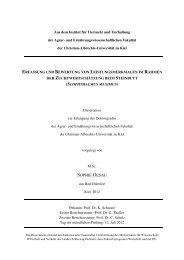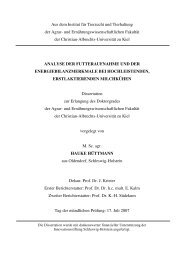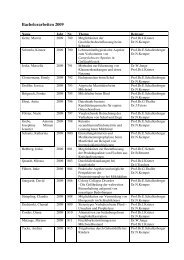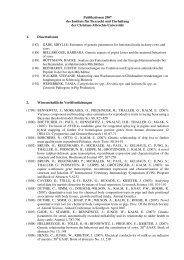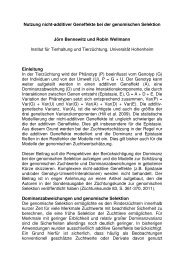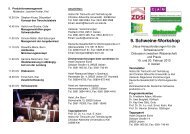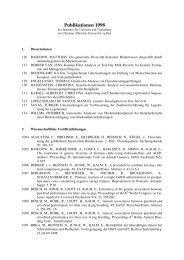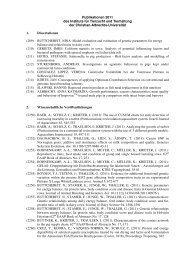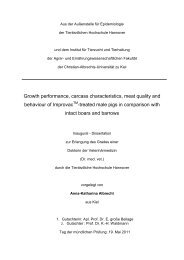Verena Gonzalez Lopez, 2011 - Institut für Tierzucht und Tierhaltung ...
Verena Gonzalez Lopez, 2011 - Institut für Tierzucht und Tierhaltung ...
Verena Gonzalez Lopez, 2011 - Institut für Tierzucht und Tierhaltung ...
Erfolgreiche ePaper selbst erstellen
Machen Sie aus Ihren PDF Publikationen ein blätterbares Flipbook mit unserer einzigartigen Google optimierten e-Paper Software.
Discussion<br />
In the last 15 years, selection schemes in Piétrain herdbook population in SH are<br />
characterized by the widespread use of genetically superior proven boars. Especially<br />
the boar to sow selection path is dominated by only a few boars (<strong>Gonzalez</strong> <strong>Lopez</strong> et<br />
al., <strong>2011</strong>). Furthermore, BLUP based selection, which has been applied since 1990<br />
in the local population, has led to an increased probability of coselecting related<br />
animals. Both circumstances increased the inbreeding level in the population in past<br />
decades and resulted in an effective population size of aro<strong>und</strong> 100 animals<br />
(<strong>Gonzalez</strong> <strong>Lopez</strong> et al., <strong>2011</strong>). Such developments are typical in systematically bred<br />
livestock populations and were also extensively investigated in cattle populations. For<br />
example Sorenson et al. (2004) identified eight ancestors that together accounted for<br />
about 50% of the genes of reference population and estimated an effective<br />
population size of 70 animals in Danish Holsteins.<br />
Increased rates of inbreeding might result in detrimental effect in the long term<br />
through a reduction in genetic variability, higher chance of appearance of <strong>und</strong>esired<br />
recessive disorders and increased inbreeding depression (Falconer and Mackay,<br />
1996). Therefore, breeding organizations focus much more on joint control of genetic<br />
progress and inbreeding in recent years.<br />
Several selection methods have been described to maximize genetic progress while<br />
constraining inbreeding (Woolliams and Meuwissen, 1993; Wray and Goddard, 1994;<br />
Brisbane and Gibson, 1995; Meuwissen and Goddard, 1997; Meuwissen, 1997). The<br />
optimum contribution method (Meuwissen 1997), implemented in the program<br />
GENCONT, has been analyzed in detail using both simulation studies (Sonesson<br />
<strong>und</strong> Meuwissen, 2002) and data from practical breeding programs, for example in<br />
five US dairy breeds (Weigel and Lin, 2002), in beef cattle and a sheep population<br />
(Avendaño et al., 2003) as well as in the UK Holstein population (Kearney et al.,<br />
2004). So far, however, only a limited number of optimum contribution selection<br />
applications in pig breeding programs were published. One example is the study of<br />
Hanenberg and Merks (2001), in which results from optimum contribution selection<br />
application with an equal contribution approach in a closed pig breeding program<br />
were compared. They fo<strong>und</strong> that the use of optimum contribution selection can<br />
improve genetic gain up to 22% at the same rate of inbreeding. Similar results were<br />
reported by Meuwissen (1997) and Gr<strong>und</strong>y et al. (1998) who used simulation studies<br />
to evaluate optimum contribution theory compared with BLUP truncation selection.<br />
52



